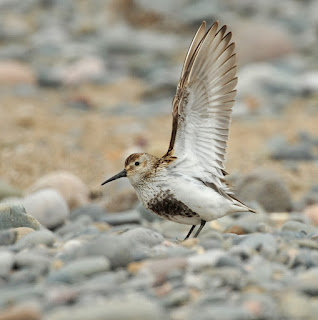The southern end of our recording area and into the Fylde.
It was a good high 10.30m tide a few minutes after mid-day yesterday, so the best bet was to park up at Pilling Lane Ends and give a bit of decent coverage along the embankment to Fluke Hall, then on to Cockers Dyke along the coastal path....A good decision, and I managed to note 40 species of wader, wildfowl, and a few small land birds.
It was a good high 10.30m tide a few minutes after mid-day yesterday, so the best bet was to park up at Pilling Lane Ends and give a bit of decent coverage along the embankment to Fluke Hall, then on to Cockers Dyke along the coastal path....A good decision, and I managed to note 40 species of wader, wildfowl, and a few small land birds.
I made little attempt at counting, though I did put in some effort to estimate up to 300 Grey Plover, 500 Bar-tailed Godwit, and interestingly just one Black-tailed Godwit. Dunlin and Knot were impressive, with smaller numbers of Curlew all viewable from Fluke Hall, and the wildfowl on the sea, high figures of Pintail, Wigeon, Teal, and Shelduck.
Rock Pipit. Pete Woodruff.
The Skylarks were overhead all the way down to Fluke Hall where I found 3 Rock Pipit, with a Pale-bellied Brent Goose on the sea, a scarce visitor to our area which took the award for 'Bird of the Day'. A Little Grebe was on Broadfleet, and a Kestrel on a fence post in this area where I flushed a Snipe.
Pink-footed Geese. Pete Woodruff.
At Fluke Hall, at least 2,000 Pink-footed Geese were in the field behind the parking area at the end Of Fluke Hall Lane. I had nothing of note along the coastal path to Cockers Dyke, but by now had seen 15 Little Egret along the route, and when I arrived I was rewarded by up to 50 Twite with 8 Greenfinch seen.
Wren. Noushka Dufort @ 1000 Pattes
Three Wren were seen along the path, in and out of the huge sea defence boulders, no one will ever know the number of these birds which have colonised these boulders, I've seen them over the years the entire length of the west coast which I have visited.
The Whooper Swan.
I made a count of 145 Whooper Swan today, 17 were on the sea off the embankment, 48 off Fluke Hall Lane, and 80 in a field at Fluke Hall.
Thanks to Noushka and Gary for their respective excellent images, they are much appreciated and even more so with a 'clik the pik' hopefully including the P.Woodruff efforts.





























